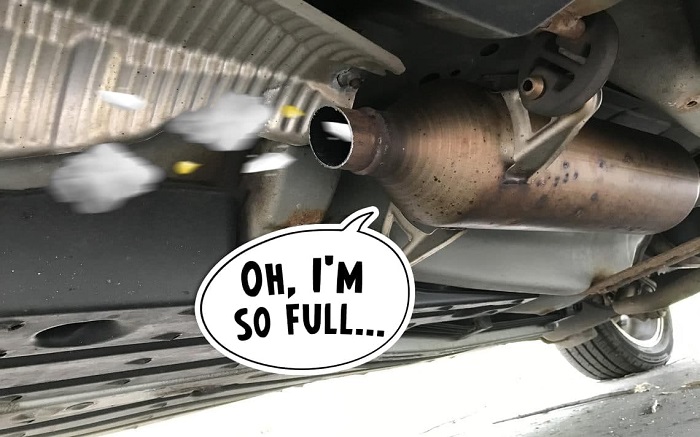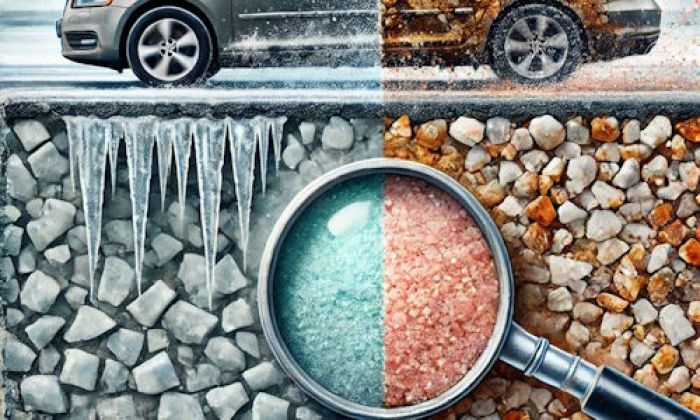
A catalytic converter is an intricate piece of machinery designed to convert toxic exhaust gasses into less harmful substances. Without it, your car will not pass emissions testing nor will it perform adequately. Sometimes it’s not obvious that your catalytic converter is indeed clogged, so be sure to watch out for these symptoms.
Common symptoms of a clogged catalytic converter:
- Check engine light is on
- Rattling noises
- Your car jerks or stalls out
- Engine misfires
- Bad fuel economy
- Subpar acceleration
- Failed emissions testing
- Rotten egg smell
- Unable to start the vehicle
- Black smoke coming out from the exhaust
The Purpose of a Catalytic Converter: Explained
Catalytic converters are designed to transform harmful substances such as carbon monoxide, nitrogen dioxide, nitric oxide, and hydrocarbons into particles with fewer harmful substances such as water vapor or carbon dioxide. The converter itself is usually made out of small honeycomb-shaped materials which are lined with a catalyst.
The catalyst's job is to react when it comes in contact with exhaust gasses in order to transform those exhaust gasses by modifying their chemical structure. Most catalysts these days are comprised out of rhodium, palladium, or platinum.
In order for a catalyst converter to work at its finest, it needs to reach the optimum operating temperature which is usually around 400 degrees Celsius. As such, converters were originally positioned closer to the engine itself, but they were later moved towards the rear of the car.
Types Of Catalytic Converters
There are a few different types of catalytic converters, but the most popular one is a simple “two-way” catalytic converter. A “two-way” catalytic converter is designed to turn harmful carbon monoxide into water vapor and carbon dioxide. This type of cat basically turns unburnt fuel particles into water.
However, newer cars come equipped with newer “three-way” cats which push the emission reduction envelope even further by also reducing the amounts of nitrogen dioxide and nitric oxide. These two pollutants are arguably even more harmful to the environment than carbon monoxide itself.
Diesel cars also come equipped with catalytic converters, but these operate a little bit differently. For starters, these converters are battling against different sorts of pollutants which means that they need injections from AdBlue in order for them to be effective.
Common Symptoms Of A Clogged Catalytic Converter:
Check Engine Light Is On
A check engine light may indicate many possible issues. However, newer car engines are equipped with fuel/air ratio sensors that are designed to monitor the performance of a catalytic converter. Whenever your toxic gas levels reach a certain level, the ECU will alert you with a check engine light. In order to remedy this issue adequately, be sure to use an OBD scanner.
Rattling Noises
Even though a catalytic converter is designed to take a bit of punishment, sometimes the fuel mixture itself can damage it. If that does happen, debris is likely to rattle inside the converter itself, and sometimes even clog the converter. If you hear any rattling the moment you start the car up, chances are that many broken pieces are rattling inside your converter.
Your Car Jerks Or Stalls Out
If your catalytic converter is clogged, then it won't be able to sustain the pressure buildup inside the converter. This symptom is almost always indicative of a clogged converter because your engine is literally unable to breathe. Whenever the pressure reaches a critical level, the engine ceases to operate. If your exhaust flow is extremely restricted all the time, your car is likely to stall out completely.
Engine Misfires
An engine misfire happens when an engine cylinder is unable to provide any power. This can be due to many different reasons. However, when this does happen, it means that your catalytic converter might get flooded with unburnt gasoline which can clog the converter or even start an engine fire. This can be extremely dangerous, so be sure to take your car in for an inspection.
Bad Fuel Economy
Another fairly common symptom of a clogged catalytic converter is a significant decrease in fuel economy. If your cats are clogged, your engine will burn more fuel because there is a reduced amount of oxygen in the engine. As far as clogged catalytic converter symptoms go, this one is indeed easy to spot. However, be sure to pinpoint the issue before you start repairing the converter.
Subpar Acceleration
If your catalytic converter becomes extremely clogged, your performance is also bound to suffer, more specifically, your acceleration. Whenever there is an excessive carbon buildup inside your catalytic converters or there is just too much unburnt fuel, your cats will become clogged. As such, your engine is not going to be able to breathe properly which will result in subpar acceleration.
Failed Emissions Testing
Many countries around the world are imposing strict rules on obligatory emissions testing, and in the US you are obligated to test your car for emissions every 1 to 2 years. Most newer cars are usually tested through the OBD port, but older models are usually tested with special hoses connected to the exhaust. A clogged catalytic converter is one of the most common reasons why people fail such testings.
Rotten Egg Smell
If you notice an odor that’s strangely similar to rotten eggs, chances are that your catalytic converter is to blame. This symptom usually means that your cats are unable to convert sulfide into odorless sulfur dioxide, which indicates either a broken or a clogged cat. Be sure not to leave your car running in a closed garage as sulfur is extremely toxic.
Unable To Start The Vehicle
If the pressure inside the catalytic converter grows to an uncontrollable level, it clogs itself completely. This means that the pressure inside the engine is going to grow dramatically and is likely going to completely lock the engine thus making it unable to start up. Engines such as these have usually been under a lot of stress before they stopped working entirely.
Black Smoke Coming Out Of The Exhaust
Whenever your catalytic converter starts clogging up, it usually means that the gasses leaving the exhaust will be significantly darker in color. This is because higher pressure starts building up in the engine until the pressure is finally high enough for those gasses to be pushed out. When that happens, the exhaust shoots dark smoke out the exhaust.
FAQ Section
How Much Does It Cost To Repair Or Buy A New Catalytic Converter?
A brand-new catalytic converter costs between $945 and $2475 with parts and labor. However, these vary greatly from one car to the other. Be sure to take your car to an experienced mechanic before you decide to buy a new cat because your old one could even be repairable at only a fraction of the cost.
Where Is A Catalytic Converter Located?
The catalytic converter sits between the exhaust manifold and the muffler. Cats are usually designed to look like a honeycomb, and they are also often breaded. This means that the catalytic converter mostly resides towards the back of a car which makes it more vulnerable to thieves.
Can You Drive A Car Without A Catalytic Converter?
If for whatever reason you are missing a catalytic converter, it's best for you to not drive your car as some states like California deem this as illegal. This means that you can theoretically pay a fine that costs more money than a brand-new catalytic converter.
Why Do People Steal Catalytic Converters?
Catalytic converters are often being stolen because they are made out of metals such as platinum, palladium, or rhodium, and these are extremely valuable to scrap metal dealers. So whenever you notice that the price of platinum is going up, be sure to park your car in a garage.
Do All Cars Come With Catalytic Converters?
Since 1975, the United States made it a requirement that all new vehicles sold have to be equipped with a catalytic converter. This means that virtually all newer diesel and gas-powered cars should come with a catalytic converter. It’s worth mentioning that hybrids also come with cats, while EVs don’t because they don’t use any fuel.
What Is AdBlue?
AdBlue is a special trade name given to a substance that assists modern-day diesel oxidation catalytic converters to transform harmful substances into water and nitrogen. The AdBlue filler cap is usually located near the fuel cap, and the tank itself is also stored near the gas tank. AdBlue is sprinkled onto exhaust gasses directly which starts a strong chemical reaction that gets rid of harmful substances.
How Much Rhodium, Palladium, And Platinum Particles Are There In A Catalytic Converter?
As previously stated, catalytic converters are filled with precious materials such as rhodium, palladium, and platinum, and that’s why many people tend to steal them. In most instances, you will find around 3-8 grams of platinum inside an average converter. You can also find up to 7 grams of palladium and only about a gram or two of rhodium.
About the authors
The CarAraC research team is composed of seasoned auto mechanics and automotive industry professionals, including individuals with advanced degrees and certifications in their field. Our team members boast prestigious credentials, reflecting their extensive knowledge and skills. These qualifications include: IMI: Institute of the Motor Industry, ASE-Certified Master Automobile Technicians; Coventry University, Graduate of MA in Automotive Journalism; Politecnico di Torino, Italy, MS Automotive Engineering; Ss. Cyril and Methodius University in Skopje, Mechanical University in Skopje; TOC Automotive College; DHA Suffa University, Department of Mechanical Engineering






Add comment